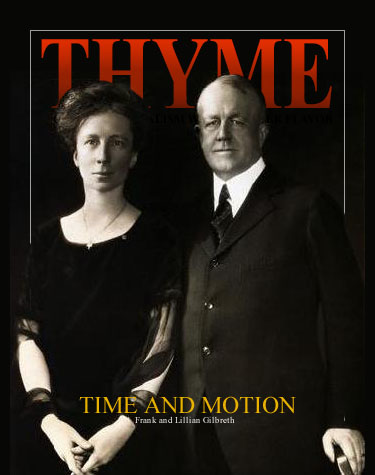
Volume VIII, Issue XIII
How the Gilbreths Changed Work
When my children were younger one of the things we enjoyed was reading the story: Cheaper by the Dozen. We later found Belles On Their Toes and continued our adventures with the Gilbreth family. The books tell the actual story of Frank Bunker Gilbreth, Sr. and his wife Lillian Moller Gilbreth from the perspective of two of their twelve children. The books focus on the life of a very interesting family, to be sure, but touch briefly on a most amazing and inspiring couple and how they changed the way we work.
Frank Gilbreth was born in 1868 in Fairfield, Maine where his father ran a hardware store. Frank's formal education ended with high school and he became a bricklayer's apprentice. It was as a bricklayer that Gilbreth began his life's work improving the way we work.
Film of Frank Gilbreth's work to improve bricklaying.
Noticing that a lot of time was spent reaching down to pick up bricks from the scaffolding below, Gilbreth devised a work level height platform for staging the bricks. The result was improved efficiency in performing the job, but an added benefit was that the workers received less fatigue from the reduction in repetitive motion. Frank Gilbreth went on to become a building contractor, but he also developed and patented a number of such innovations that improved efficiency and workflow.
He became sought after as a consultant and became involved in the engineering process for many industrial processes. He lectured at Perdue University and founded his own consulting firm with his wife Lillian as collaborator. Together they studied how work was done in factories and offices and devised better ways to accomplish it. Their office is described in Cheaper by the Dozen. Gilbreth Inc. consisted of Frank and Lillian sitting across from each other at a colossal table/desk where they performed their analysis.
When the Simmons Harware Company built their large warehouse in Soux City, Iowa, they hired the Gilbreths to design and manage the flow of work and materials, a process often taken for granted as part of construction design today. When World War I began, Frank Gilbreth went to work developing procedures for rapidly assembling weapons, reducing it to a relatively simple series of steps. He developed a system whereby soldiers could train blindfolded and successfully assemble their rifles, allowing them to smoothly do so in total darkness if required to later.
The Gilbreth's work even led to improvements in medicine. It was their idea to have a "caddy" hand instruments to a surgeon during operations. The Gilbreths employed motion picture technology to analyze and identify essential motions. Then they refined them. These "Therbligs" (Gilbreth spelled somewhat backwards) became the building blocks of improved workflow. It is worth noting that while their contemporary Frederick Winslow Taylor sought to reduce the time it took to DO each process, the Gilbreths sought to reduce the number of processes and so make the worker more productive through the wise focus of their energy.
"Blessed is the man who makes two blades of grass grow where only one grew before. More blessed is he who multiplies the harvests of toil not merely two-fold, but three-fold or more-fold, for he virtually lengthens life when be adds to its fruitage. Such a man is Frank B. Gilbreth who tells in this book just how he wrought this wonder. For years he has closely watched workers at tasks of all kinds ; he has discovered how much they lose by moving unprofitably hither and thither, by neglecting to take the shortest and easiest paths. In the ancient trade of bricklaying he has increased the output almost four-fold by doing only what must be done, and using a few simple devices of his own invention."
--George Iles (1917) in: "Introduction" of Applied Motion Study
"Management practitioners today largely ignore Frank and Lillian Gilbreth, possibly because the principles of motion study they pioneered are now very unfashionable. Motion study entailed the detailed examination of the movements individual workers made in the process of carrying out their work. It was, however, just one of the concepts the Gilbreths developed. Through Frank's concerns that the efficiency of employees should be balanced by an economy of effort and a minimisation of stress, and Lillian's interest in the psychology of management, their work laid the foundations for the development of the modern concepts of job simplification, meaningful work standards and incentive wage plans."
--Editors Of Perseus Publishing (2002) Business: the ultimate resource. p. 994
Frank Gilbreth died of a heart attack on June 14, 1924. He was 55. He died as he was talking on the telephone at the Lackawanna railway station in Montclair, New Jersey. Lillian Gilbreth continued in the work that they had shared. She was a brilliant person in her own right, having received an undergraduate degree from the University of California in English. She went on to obtain her Phd. in Industrial Psychology in 1915 from Brown University. Her dissertation subject: Some Aspects of Eliminating Waste in Teaching.
Most of us are familiar with the fact that the Gilbreths had twelve children, carting them about in the Pierce Arrow nicknamed "Foolish Carriage." Cheaper by the Dozen has indeed immortalized this family. Perhaps what is forgotten is the contribution they made to American life, enriching the way we live and work.
20th Anniversary of Opus 24
An Evening of Beautiful Music Offered to the LORD

The organ at Christ Lutheran Church in Staunton.
Friends of Christ Lutheran Concert Series; Celebrating the 20th anniversary of the Taylor and Boody Pipe Organ installed at Christ Lutheran Church with a Choral and Organ concert. This will be Sunday, September 28th at 4pm. We will be presenting Bach's Cantata 80 "A Mighty Fortress is our God" with professional soloists and instrumentalists. The choir will also be singing Cantate Domino by Pitoni, César Frank's Psalm 150, and Nunc Dimittis by Ralph Vaughan Williams.
Does My Vote Really Matter?
The importance of One Vote!
In 2004, Christian voter turnout increased by 93 percent over the 2002 turnout, and 42 percent of voters identified abortion as an important issue. As a result:
• 63 percent of the freshman U.S. congressmen elected were pro-life.
• 77 percent of the freshman U.S. senators were pro-life.
By increasing pro-life representation in Congress in the 2002 and 2004 elections, America witnessed the first four major abortion-restricting bills enacted since Roe v. Wade:
• Infants Born Alive Protection Act
• Unborn Victims of Violence Act
• Partial-Birth Abortion Ban
• Fetal Farming Ban
In addition, those senators helped confirm strict constructionists John Roberts and Samuel Alito to the U.S. Supreme Court. By 2006, Christian voter turnout decreased by 30 percent from the 2004 numbers, and only 30 percent of voters said that abortion was an important issue. As a result:
• Only 31 percent of the freshman U.S. congressmen elected were pro-life.
• Only 10 percent of the freshman U.S. senators elected were pro-life.
• The Baltimore Sun labeled the 2007 Congress as “the most pro-choice Congress in the history of the Republic.”
Your vote does matter, and you have the opportunity to protect life, marriage and family. Will you commit to cast your vote in support of the family this November?
Virginia Voter Information:
State General Election: November 4, 2014
Virginia polling times: 6:00am to 7:00pm
Registration deadline October 14, 2014
Register Online [click to register].




1 comment:
James Renwick Manship writes: "Ben Franklin's mother had 17 children. No wonder he turned out so wise! Ben's letter to his daughter about the importance of attending church for prayer is a classic. Susannah Wesley, mother of evangelists John and Charles Wesley, had 25 children. She obviously had a "Method", and with God the Father and their father on Earth, created the founders of the Methodist denomination."
Post a Comment